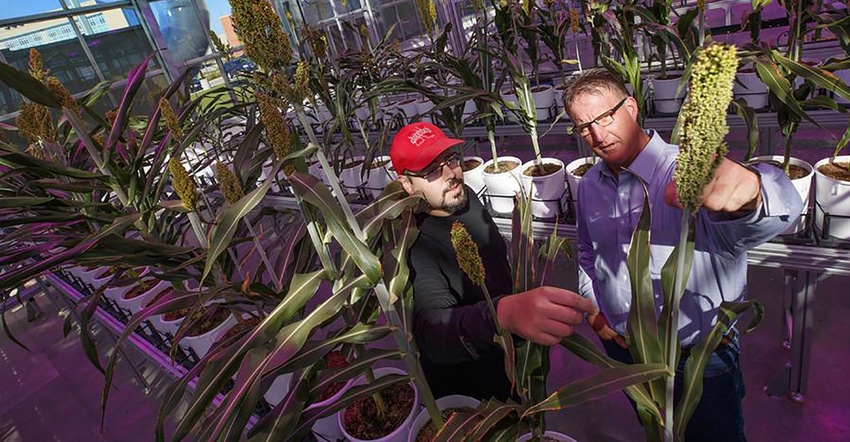December 13, 2018

Synthetic nitrogen fertilizer is lauded as one of the biggest agricultural breakthroughs of the 20th century, sparking a boom in food production that supported a global population that grew from 1.6 billion to 6 billion.
A century later, the global population — and its food demands — continue to climb. Today’s agricultural researchers are turning to plant genomics to find solutions for growing crops more sustainably with fewer inputs, including nitrogen fertilizer.
A University of Nebraska-Lincoln research team and collaborators at the Alabama-based HudsonAlpha Institute for Biotechnology are seeking a solution that would reduce nitrogen fertilizer use without sacrificing yield or profit: plants bred with the ability to use nitrogen more efficiently.
The researchers are advancing this work with a $3.9 million grant from the National Science Foundation. UNL's share of the award is about $1.3 million.
Although nitrogen fertilizer is an important tool in agriculture, it’s not without downsides: from the natural resources used to manufacture the fertilizer to the cost to producers’ bottom lines to the environmental impacts resulting from overuse.
“Plants with better nitrogen efficiency would mitigate some of the problems of excessive fertilizer because we could reduce the amount of nitrogen required to get the same yield,” said James Schnable, UNL assistant professor of agronomy and horticulture. “And it would help farmers be proactive in reducing their fertilizer use, whether to save money or to cope with environmental regulations that may come about.”
To produce this heightened efficiency, the team is combining genomics, biotechnology and automated phenotyping in a three-phase research plan focused on sorghum. The cereal crop is considered vital to solving food insecurity because it’s relatively water- and nitrogen-efficient and thrives in varied climates.
First, the HudsonAlpha group will comb through crop data to identify sorghum’s key gene networks involved in nitrogen use, identifying them as targets for change. UNL agronomist Tom Clemente will then use cutting-edge genome editing technology to add genetic variations that govern these networks, producing new varieties to pass on to Schnable and Nebraska researchers Yufeng Ge, assistant professor of biological systems engineering, and Jinliang Yang, assistant professor of agronomy and horticulture.
That group will work together to use automated phenotyping to analyze the new sorghum breeds’ traits. Then, the cycle begins again as Schnable will return findings to the HudsonAlpha team, which can further home in on the gene networks at play.
Schnable’s work, called high-throughput phenotyping, capitalizes on the university’s state-of-the-art LemnaTec High-Throughput Plant Phenotyping System, located at Nebraska Innovation Campus’ Greenhouse Innovation Center.
The system captures a plant’s physical and biochemical properties, known as phenotyping, through a robotics-based process that moves conveyor belts of plants through several 360-degree imaging chambers.
These cameras will produce high-resolution images of the modified sorghum plants across their 12- to 18-week life cycle. Software will then analyze their biomass and nitrogen abundance, providing clues about whether the genome edits succeeded in boosting nitrogen efficiency.
Phenotyping itself isn't a new practice, Schnable says. It’s the ability to monitor the same plant periodically across its lifetime, without physically destroying it to take measurements, that makes the high-throughput approach so valuable.
And Nebraska’s facility is particularly well-suited to study sorghum, which often grows 5 to 6.5 feet, tall. The university’s phenotyping system can measure plants up to 8 feet tall, making Lincoln one of the few places in the world capable of this kind of research.
Clemente is contributing expertise in a technology equally revolutionary through CRISPR/Cas9, a gene-editing technique that enables scientists to add novel variation to the genetics of plant cells. For the past three years, his laboratory has been using this tool in plants like tomato, soybean, maize, wheat and sorghum, making genetic changes designed to impart beneficial traits that can be integrated into breeding programs.
For this project, Clemente’s team will introduce variations to genes that are key players in nitrogen use.
The project’s education component focuses on helping budding scientists, from high school to postdoc, gain plant science skills. As part of this, undergraduates from underprivileged parts of Alabama, with little access to academic research, will spend a year at HudsonAlpha learning the basics of agricultural genomics.
Nebraska will then host the group in three of its NSF-funded Research Experiences for Undergraduates summer programs, providing plant science training.
The project, a Track-2 Focused EPSCoR Collaboration, is funded through NSF’s EPSCoR Research Infrastructure Improvement Program. EPSCoR, the Established Program to Stimulate Competitive Research, is designed to improve research infrastructure in jurisdictions with a relatively small share of NSF’s total research budget. Nebraska and Alabama are EPSCoR states.
This report comes from UNL CropWatch.
You May Also Like




